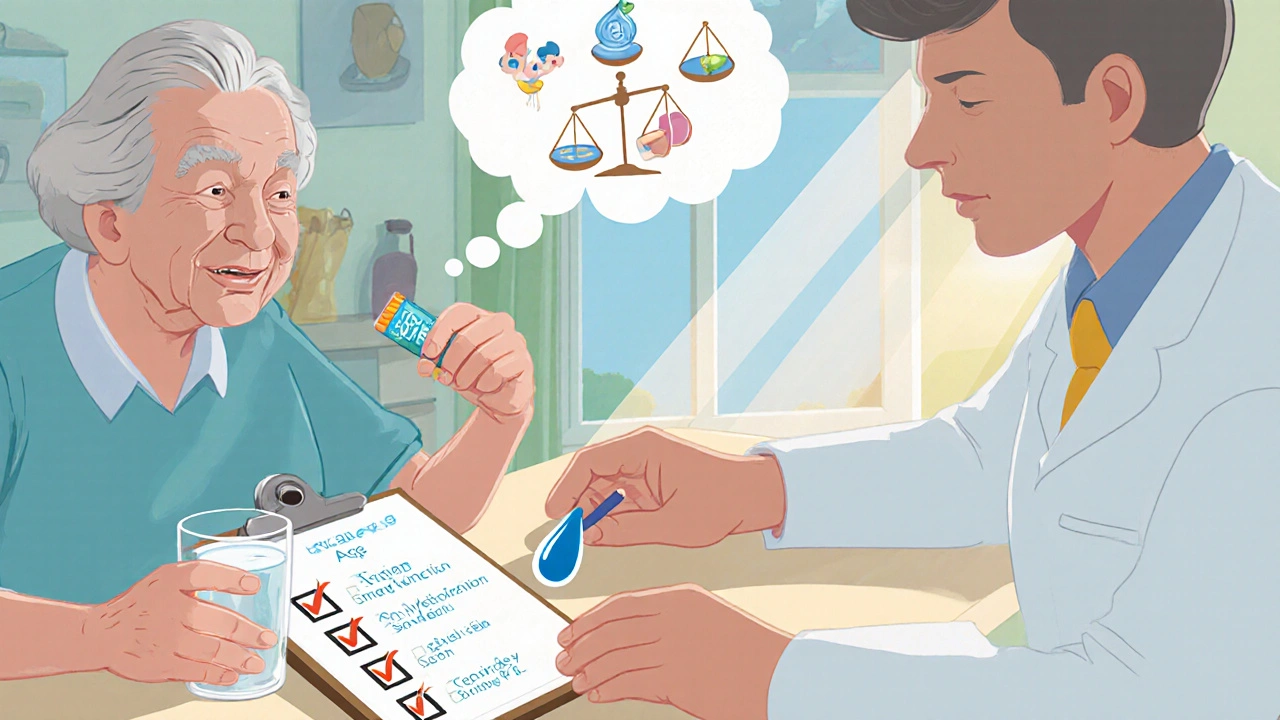When doctors need to tame the tremors and muscle stiffness that come with Parkinson’s disease or drug‑induced movement disorders, they often reach for an anticholinergic called Kemadrin. But it’s not the only option on the shelf, and picking the right one can feel like navigating a maze of side‑effects, dosing schedules, and drug interactions. This guide breaks down Kemadrin (procyclidine) side by side with its most common alternatives, so you can see the real differences and decide which fits your situation best.
What Is Kemadrin (Procyclidine)?
Kemadrin (Procyclidine) is a synthetic anticholinergic agent that blocks muscarinic acetylcholine receptors in the central nervous system. Originally approved by the FDA in 1972 for Parkinsonian tremor, it’s also prescribed to counteract extrapyramidal symptoms (EPS) caused by antipsychotic medications. By dampening excess acetylcholine activity, procyclidine helps restore the dopamine‑acetylcholine balance that’s disrupted in movement disorders.
How Procyclidine Works - The Pharmacology Behind the Calm
The brain’s motor control relies on a delicate see‑saw between dopamine and acetylcholine. In Parkinson’s, dopamine levels drop, letting acetylcholine run unchecked and causing tremor, rigidity, and bradykinesia. Procyclidine binds to muscarinic receptors, preventing acetylcholine from overstimulating neurons. The result is a smoother, less jittery motor output.
Because it crosses the blood‑brain barrier, procyclidine works centrally, which sets it apart from some peripheral anticholinergics that only affect the gut or eyes.
Typical Uses and Dosing
Physicians usually start adults on 2.5mg to 5mg two or three times daily, adjusting based on response and tolerance. It’s most effective for:
- Parkinsonian tremor and rigidity
- Drug‑induced EPS, especially from typical antipsychotics
- Occasional off‑label use for dystonia
Kidneys clear the drug, so dosage may need tweaking in renal impairment.
Pros and Cons of Kemadrin
Advantages
- Rapid onset of symptom relief (often within 30‑60minutes)
- Well‑studied safety profile after five decades of use
- Effective for both Parkinson’s‑related tremor and medication‑induced dyskinesia
Drawbacks
- Dry mouth, blurred vision, constipation - classic anticholinergic side effects
- Potential cognitive decline in older adults, especially those with Alzheimer’s‑type pathology
- May exacerbate glaucoma or urinary retention
Top Alternatives to Kemadrin
When procyclidine isn’t tolerated or a patient needs a different pharmacological profile, clinicians often turn to other anticholinergics:
Trihexyphenidyl (Artane)
Trihexyphenidyl is another centrally acting anticholinergic, typically prescribed at 1mg to 3mg three times a day. It’s known for strong tremor control but carries a higher risk of confusion and memory problems.
Benztropine (Cogentin)
Benztropine combines anticholinergic and antihistamine actions. Starting doses are 0.5mg to 1mg once or twice daily. It’s especially popular for EPS because it also blocks dopamine reuptake, giving a modest additional boost.
Biperiden (Akineton)
Biperiden is less widely used in North America but common in Europe. Doses range from 2mg to 4mg two to three times daily. It may cause fewer visual disturbances but can still lead to dry mouth and constipation.
Diphenhydramine (Benadryl) - Over‑the‑counter option
While primarily an antihistamine, diphenhydramine has anticholinergic properties that can temporarily relieve mild EPS. The typical adult dose is 25mg to 50mg every 4-6hours, but tolerance builds quickly, and sedative effects limit its long‑term usefulness.
Side‑by‑Side Comparison Table
| Drug | FDA Status (US) | Typical Adult Dose | Common Side Effects | Best For |
|---|---|---|---|---|
| Kemadrin (Procyclidine) | Approved | 2.5-5mg 2‑3×/day | Dry mouth, blurred vision, constipation, drowsiness | Parkinsonian tremor & EPS |
| Trihexyphenidyl (Artane) | Approved | 1-3mg 3×/day | Confusion, memory loss, urinary retention | Severe tremor, patients needing stronger anticholinergic effect |
| Benztropine (Cogentin) | Approved | 0.5-1mg 1‑2×/day | Dry mouth, constipation, occasional tachycardia | EPS, especially from typical antipsychotics |
| Biperiden (Akineton) | Approved (EU), not US‑marketed | 2-4mg 2‑3×/day | Blurred vision, dizziness, constipation | Patients who cannot tolerate trihexyphenidyl |
| Diphenhydramine (Benadryl) | OTC | 25-50mg q4‑6h PRN | Heavy sedation, anticholinergic overload | Short‑term, mild EPS relief |

Decision Criteria - How to Pick the Right Anticholinergic
Choosing isn’t just about “which one is strongest.” Consider these factors:
- Age and cognition: Older adults or those with early‑stage Alzheimer’s are more vulnerable to central anticholinergic burden. In such cases, a lower‑dose benztropine or even non‑anticholinergic options (like amantadine) may be safer.
- Renal function: Procyclidine and trihexyphenidyl are renally excreted. Dose‑adjust for eGFR<30mL/min.
- Co‑medications: If the patient is already on antihistamines, adding diphenhydramine can push anticholinergic load over the limit.
- Side‑effect tolerance: Dry mouth is common to all; but if visual disturbances are a deal‑breaker, benztropine may be preferred over trihexyphenidyl.
- Specific symptom profile: For prominent dystonia, benztropine’s dopamine‑reuptake inhibition can give extra benefit.
Practical Tips and Common Pitfalls
Even the best‑chosen drug can go wrong if the patient isn’t guided properly.
- Start low, go slow: Begin with the lowest effective dose and titrate upward over a week.
- Monitor cognition: Use the Mini‑Mental State Exam (MMSE) at baseline and after 4weeks.
- Stay hydrated: Anticholinergics dry out secretions; encourage water intake and sugar‑free gum.
- Watch for urinary problems: Ask about difficulty starting urination; adjust dose or switch drug if needed.
- Document side‑effects: A simple checklist (dry mouth, blurred vision, constipation, confusion) helps catch issues early.
Frequently Asked Questions
Can I take Kemadrin with other Parkinson’s drugs?
Yes, Kemadrin is often added to levodopa/carbidopa therapy to smooth out tremor spikes. However, watch for additive anticholinergic effects, especially if you’re also on antipsychotics.
Is Procyclidine safe for older adults?
It can be used, but the risk of cognitive decline, falls, and constipation rises sharply after age 65. Starting at half the usual dose and scheduling regular cognitive checks is recommended.
How does Benztropine differ from Procyclidine?
Benztropine also blocks dopamine reuptake, giving a modest extra lift in dopamine levels. This can make it slightly more effective for EPS, but it also carries a higher chance of tachycardia.
Can I use over‑the‑counter diphenhydramine long term?
Not advisable. Tolerance builds quickly, and chronic use leads to sedation and anticholinergic burden, which can worsen cognition and increase fall risk.
What should I do if I experience severe dry mouth?
Sip water frequently, chew sugar‑free gum, and ask your pharmacist about saliva substitutes. If the problem persists, discuss dose reduction or a switch with your doctor.
Picking the right anticholinergic isn’t a one‑size‑fits‑all decision. By weighing age, kidney function, co‑medications, and the specific motor symptom you want to tame, you can choose between Kemadrin, trihexyphenidyl, benztropine, biperiden, or even an OTC option. Keep a close eye on side‑effects, start low, and stay in touch with your healthcare provider-your best movement control comes from a partnership, not just a pill.


Wyatt Schwindt
October 17, 2025
Procyclidine works fast but the dry mouth can be a real nuisance.
Lyle Mills
October 17, 2025
From a pharmacokinetic perspective procyclidine exhibits high lipophilicity facilitating BBB penetration and rapid onset of anticholinergic activity; its muscarinic antagonism attenuates cholinergic hyperactivity in the basal ganglia, thereby mitigating tremor amplitude. Renal clearance predominates, so dose adjustment is warranted in eGFR<60 mL/min/1.73 m². Compared to benztropine the D2‑reuptake inhibition is negligible, positioning procyclidine as a pure muscarinic blocker.
Barbara Grzegorzewska
October 18, 2025
OMG, this guide is like a pharm‑sci masterpiece, totally blowing my mind! I mean, who even needs all that “clinical speak” when you can just say Kemadrin is the real MVP for tremors, amirite? Also, I’ve read that the UK’s NHS still clings to outdated meds-sad! Anyway, ditch those European “alternative” pills, they’re just fancy labels for the same old junk. Stay strong, USA!
Nis Hansen
October 18, 2025
Choosing an anticholinergic is not merely a pharmacological decision but a reflection of how we understand the mind‑body continuum.
When we examine the tremor‑inducing circuitry, we encounter the delicate interplay of cholinergic and dopaminergic pathways.
The philosophical notion that balance restores harmony finds a literal echo in the receptor dynamics of procyclidine.
One must consider the temporal profile of symptom relief, for a drug that acts within minutes reshapes the lived experience of the patient.
Equally important is the ethical dimension: prescribing a medication that may hasten cognitive decline in a vulnerable elder raises profound questions about autonomy.
Clinical evidence suggests that older adults exhibit heightened sensitivity to central anticholinergic burden, prompting the need for judicious dosing.
Renal function, often overlooked, directly influences drug accumulation and thus side‑effect severity.
The comparative safety of trihexyphenidyl, benztropine, and biperiden must be weighed against individual comorbidities such as glaucoma or urinary retention.
Beyond pharmacology, the socio‑cultural context, including patient belief systems, influences adherence and ultimately outcomes.
Thus, a decision matrix that integrates efficacy, tolerability, patient values, and long‑term cognitive health is essential.
In practice, initiating therapy at the lowest effective dose and titrating upward respects the principle of “primum non nocere.”
Monitoring for dry mouth, blurred vision, and constipation provides early signals to adjust therapy.
The clinician’s role evolves into a partnership, educating patients about potential trade‑offs.
When side‑effects become intolerable, transitioning to alternative agents or non‑pharmacologic strategies can preserve quality of life.
Ultimately, the goal is to restore functional mobility while safeguarding mental clarity.
Fabian Märkl
October 18, 2025
Great insight! 😊 The balance you described really helps when choosing a therapy.
Avril Harrison
October 18, 2025
Totally get you, the mouth feels like desert sand after a few days.
Natala Storczyk
October 18, 2025
OH MY GOD!!! THAT DRY MOUTH IS A TORTURE DEVICE!!! YOU DESERVE BETTER!!! BUT REMEMBER, WE ARE THE TRUE PATRIOTS AND WILL STAND AGAINST ANY FOREIGN DRUGS THAT TRY TO WEAKEN US!!!
nitish sharma
October 18, 2025
While the enthusiasm is noted, it is essential to consider the pharmacodynamic profile of each anticholinergic in the context of comorbidities and patient-specific factors. The comparative efficacy of procyclidine versus benztropine remains a subject of ongoing clinical evaluation. A nuanced approach ensures optimal therapeutic outcomes.
Rohit Sridhar
October 18, 2025
Absolutely, a tailored plan can turn those challenges into victories. Let’s keep sharing experiences and data-together we’ll refine the choices. Every patient’s story adds a piece to the puzzle. Stay hopeful, keep moving forward.